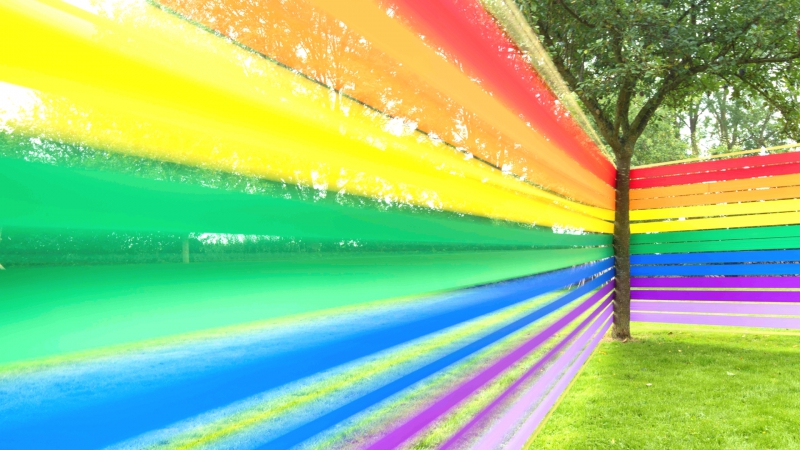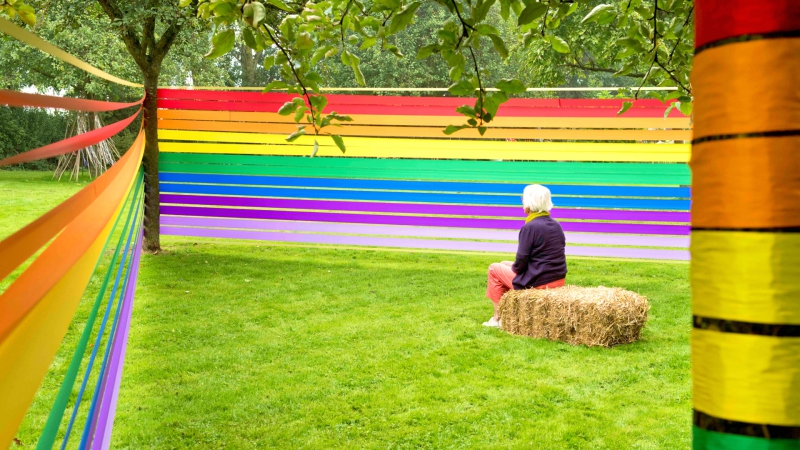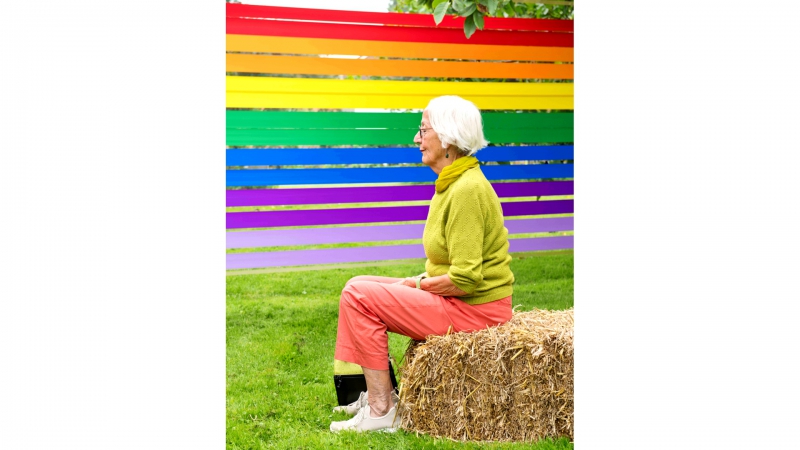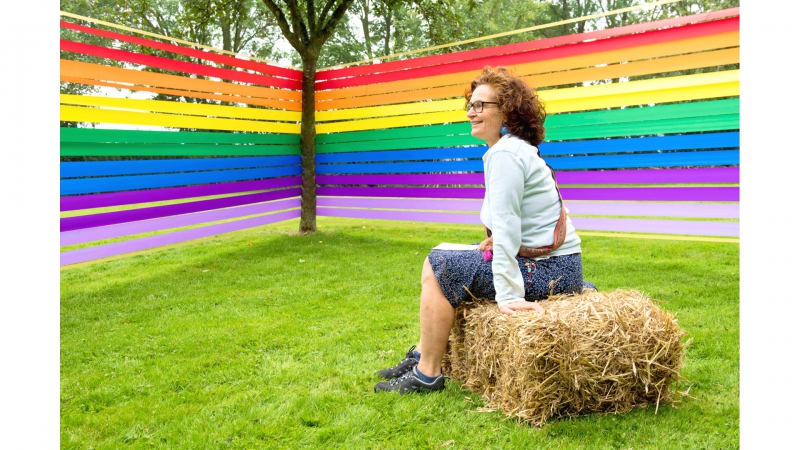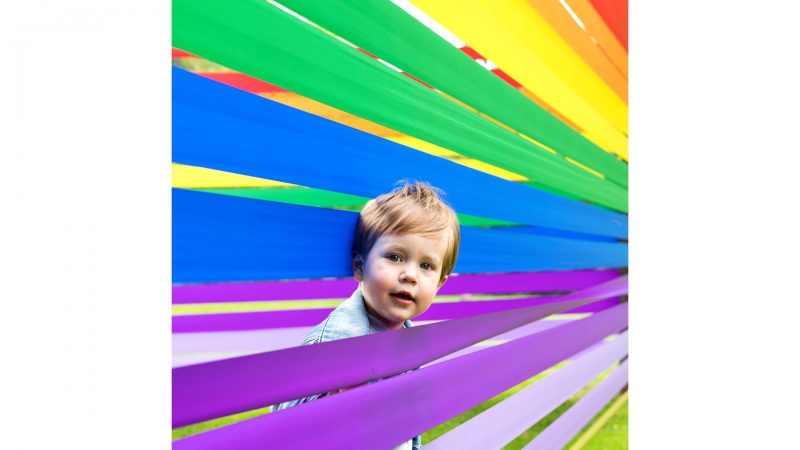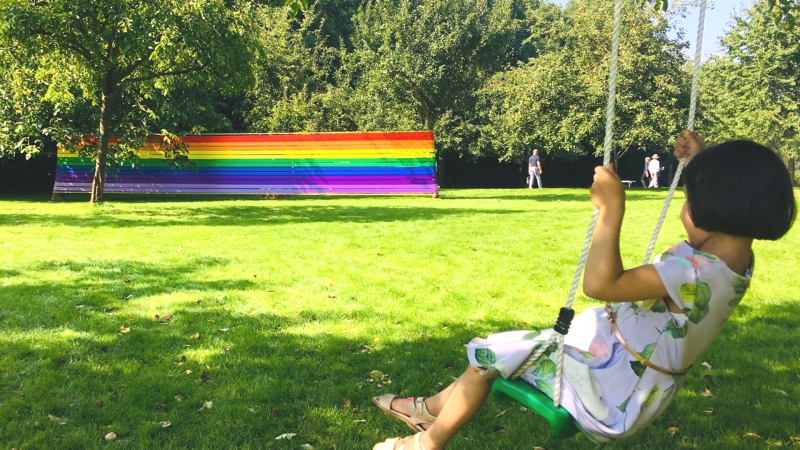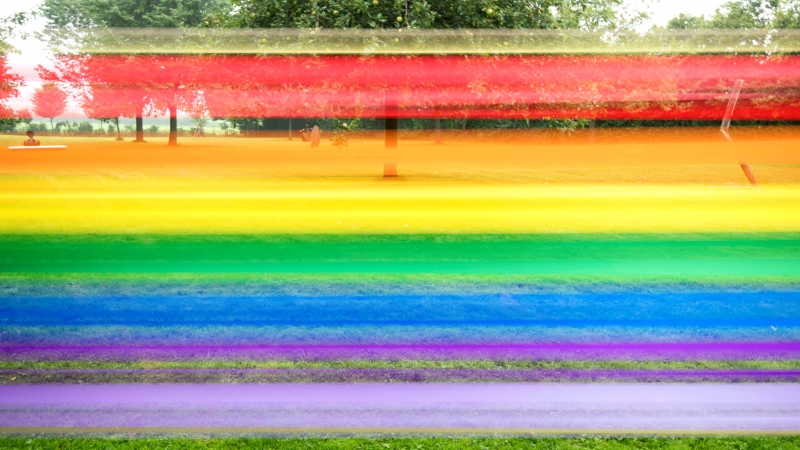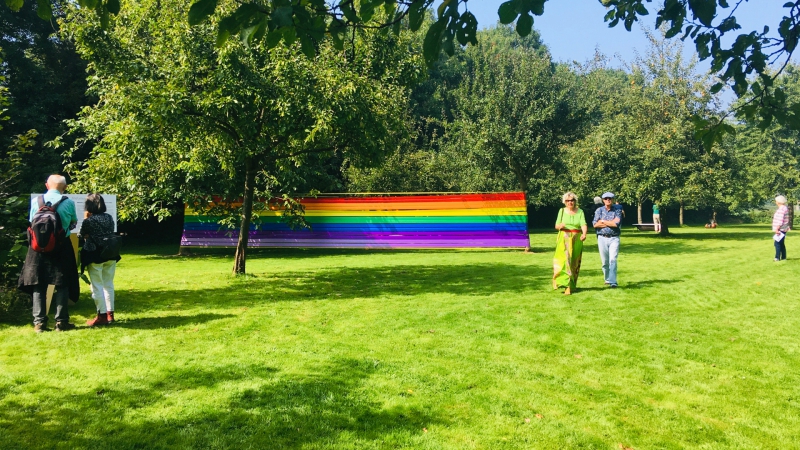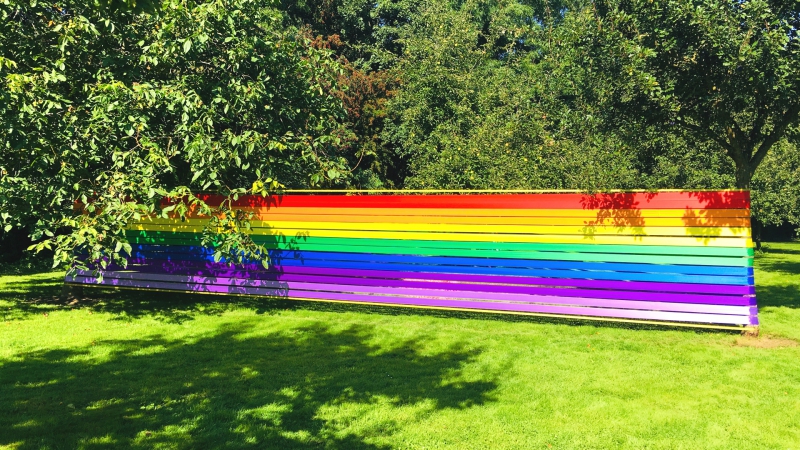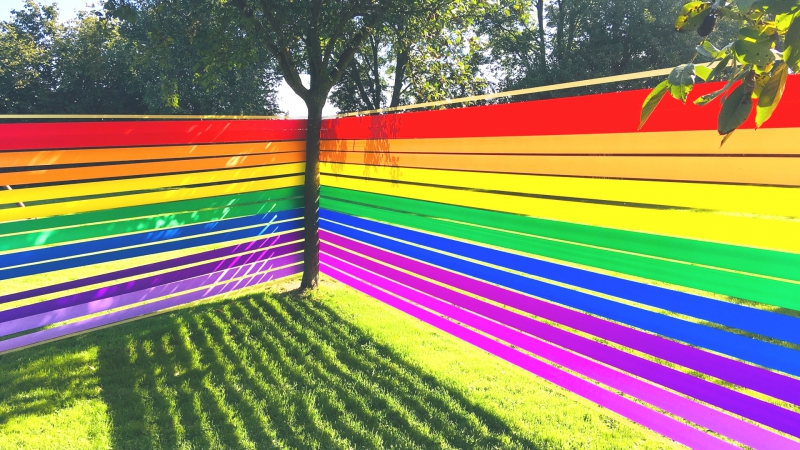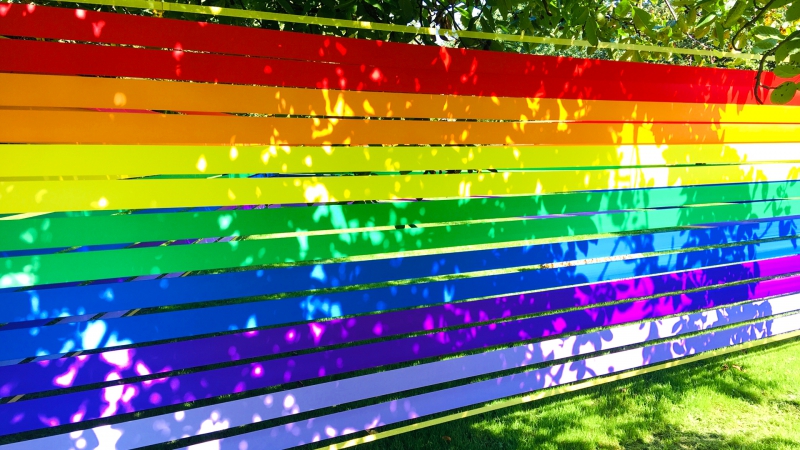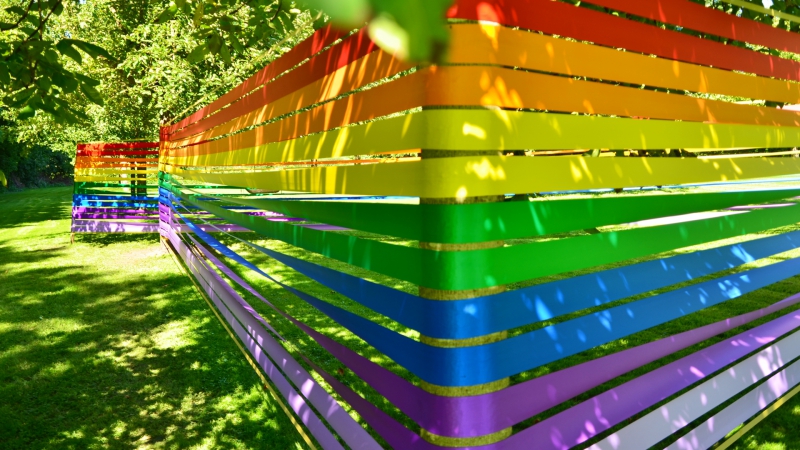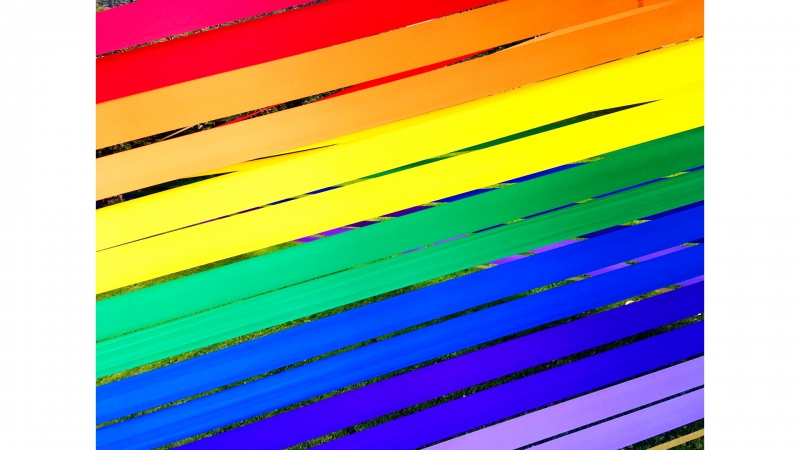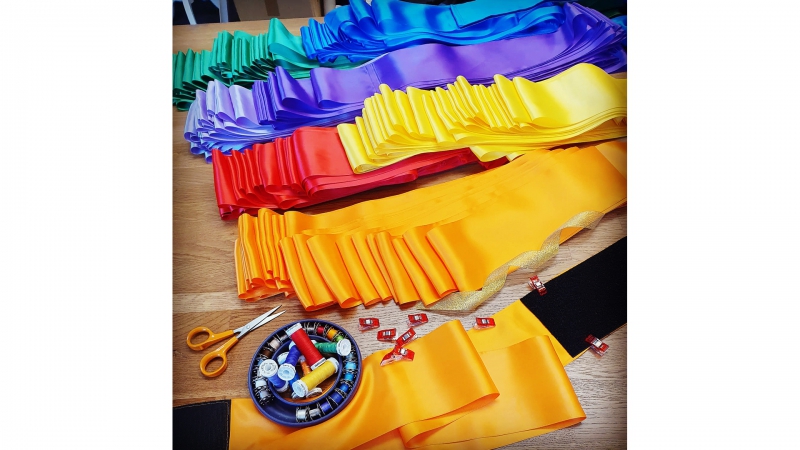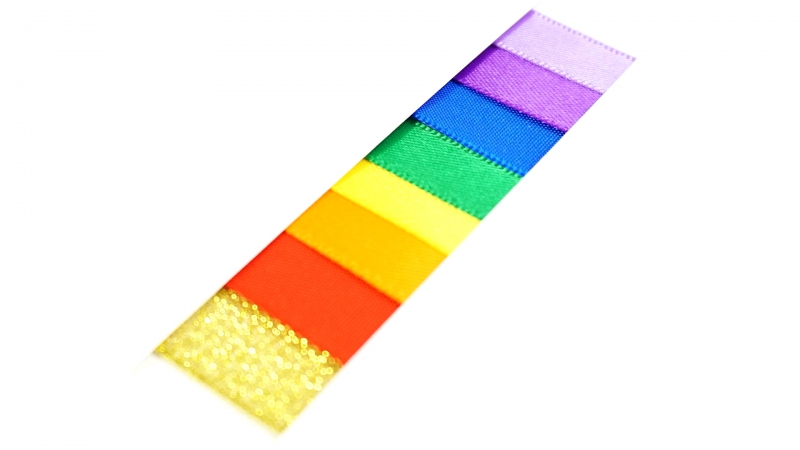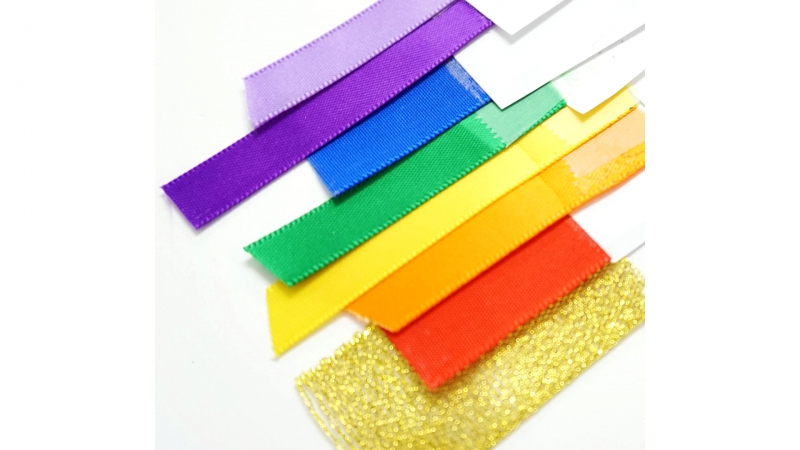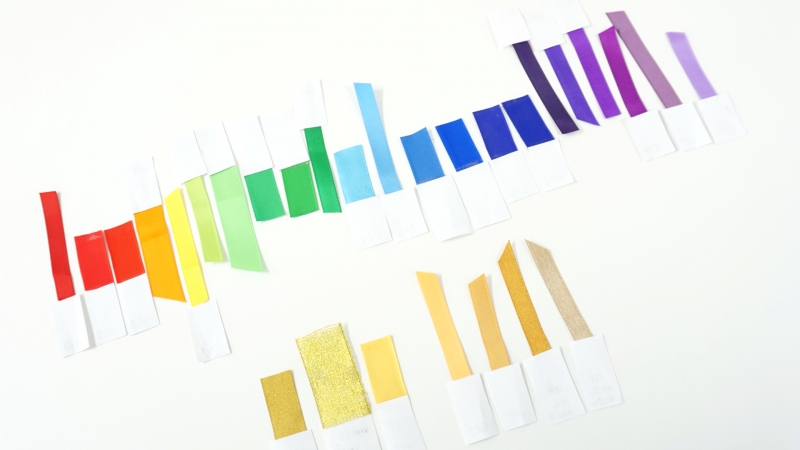Inside the rainbow (you find yourself)
On September 4 and 5, 2021 the art installation Inside the rainbow (you find yourself) could be seen and experienced during the annual art event plateauKUNST in South Limburg, the Netherlands. The event was attended by more than 3000 visitors.
Inside the rainbow (you find yourself) was an exuberant, colorful and universal art project in the outdoor area of the municipality of Eijsden-Margraten. On the one hand, the installation by artist Jonathan Wanders draws attention to relevant issues and developments such as (bio)diversity, inclusivity (equality), tolerance, solidarity and society. On the other hand, it is a symbol of hope and happiness for the future.
Art installation
In the orchard at Gasthuis 67 (Bemelen, NL) a temporary and contemporary installation had been created by stretching satin ribbons around three different fruit trees: a walnut tree, apple tree and plum tree. The satin ribbons consisted of 10 cm wide ribbons in 7 rainbow colors (violet, indigo, blue, green, yellow, orange, red) and 2.5 cm wide gold ribbons. The colors symbolize the rainbow and the sun. The ribbons connected the three trees at the same height from grass height to 2 m. Since the trees are at a distance of approximately 11 meters from each other, a triangular pavilion of approximately 55 m2 was created. An entrance was realized by 'folding open' one side of the triangle and attaching the ribbons around a wooden pole. There was no nailing or screwing into the trees. The ribbons were folded around the trees and pole, sewn in a loop and attached with Velcro. Because the ribbons were under tension, they stay in place. A straw bale was placed in the middle of the installation on which one could sit.
Diversity and inclusivity (equality)
Inside the rainbow (you find yourself) celebrates the diversity of all life on earth, including the values of inclusivity (equality), tolerance and solidarity (society). This ties in with current topics such as the decline in biodiversity, the Black Live Matters protests and LGBTI+ acceptance. These (social) themes are brought to the attention of a diverse and broad audience in an accessible and positive way. In view of this theme, the universal and powerful symbolism of rainbow and sun has been chosen. The rainbow colors symbolize the diverse and varied life on our earth. For people in all their colours, in all their diversity. And without sun, no life. No sun, no rainbow. The themes of (bio)diversity and equality were emphasized by the location of the art installation in an orchard and because the rainbow connects 3 different fruit trees, lovingly embracing them. Because a rainbow also stands for connection and unity.
Hope and happiness
On the other hand, the art installation is a symbol of hope and happiness for a better and more beautiful future. This refers to another topical issue: the global crisis and the consequences of the coronavirus. In many cultures the rainbow has an important, special and above all positive meaning. It is a universal, connecting, powerful and recognizable symbol.
Interaction and reflection
The art installation interacted (dialogue) with the context as well as with the visitors. The interaction with the context is about greenery, tranquility and natural versus colorful, exuberant and artificial, open versus closed. Although everything has been designed in advance, there is room for chance: wind, (sun)light, leaf growth, fruit development, shadow effect, etc. The interaction with the visitors went deeper: the outside was experienced simultaneously by several people, taking into account approximately 2,500 visitors during the art event. However, the installation itself was only accessible to 1 person at a time. This to experience an ultimate and intimate experience, but also taking into account the Covid-19 measures. The art installation offered a place of reflection and silence, hence the name Inside the rainbow (you find yourself). In the rainbow you can 'find yourself', disconnect from the crowd and crowds, to focus on what makes yourself most happy or what matters to you. This is a reference to the myth of the pot of gold at the end of the rainbow. The symbol of wealth and prosperity. It holds a promise. The true wealth is not the pot of gold, but inner peace, happiness.
The installation was therefore designed as a sacred space, a kind of contemporary church for everyone, where one can stay alone for a while. With tree trunks as columns, a roof of leaves, colorful ribbons as walls and a straw bale on which to sit. The temporary aspect of both the experience and the art installation itself made the entire experience special and fits in well with the ephemeral character of the rainbow.
Ambivalence
An extra substantive, deeper layer was added because with this installation Jonathan explores the ambivalence of our relationship with each other and with nature. Because it is also about contradictions, comparable to the emergence of a rainbow out of opposites. The rain is associated with sadness and misfortune, the sun with joy, prosperity, hope and life. Remember the proverb “After rain comes sunshine”. When these two 'opposites' coincide, an extra dimension becomes temporarily visible: a rainbow.
The art installation Inside the rainbow (you find yourself) was on the one hand interwoven with the context, by literally making the connection and making use of 'what is'. On the other hand, a contrast was created through the exuberant, artificial use of color, the demarcation of part of the open space and by isolating the 3 fruit trees from the group of trees that are in a tight grid. This says something about our relationship with each other and with nature: It's about individual vs group, artificial vs natural, appropriating nature and putting it to one's own hands. Our disconnection from nature. Jonathan finds this ambivalence interesting. It provides food for thought, such as the colors moving and frolicking with each other in the rainbow. As if the colors enter into a dialogue with each other and the environment.
Sensation and perception
The installation is part of Wander's overarching study of sensation and perception: the sensitive experience, dynamics, stratification and interaction (dialogue) between artwork and spectator (participant). For some, the installation is just a beautiful, colorful work, for others it goes deeper and has more meaning. For some it results in a beautiful Instagram photo, for others a moment of reflection by taking a seat on the straw bale in the installation. Both interpretations are equally valuable to Jonathan. One can read the entire explanation or choose to enter the installation and just experience it.
Rainbow
The rainbow (with sun) is a recurring theme in Jonathan's works. Besides being a universal symbol for values Jonathan believes in and is committed to, such as diversity, equality, tolerance and solidarity, the rainbow also has a personal aspect. Jonathan, like his son David, is a rainbow baby.
News
- Review art installation ‘Inside the rainbow (you find yourself)’ - plateauKUNST 2021 (selection) // 21 Oktober 2021 (read the complete NL review here)
- Catalog plateauKUNST 2021 (selection, NL) // 4 and 5 September 2021 (watch the complete catalog here)
Title: Inside the rainbow (you find yourself)
Location: Orchard at Gasthuis 67, 6268 NN Bemelen (NL), along the street Franse Steeg. The installation was publicly accessible.
Process: April to August 2021
Period: Weekend of 4 and 5 September 2021, during plateauKUNST art event.
Material: Double-sided satin ribbon (violet, indigo, blue, green, yellow, orange, red: 100mm wide) and organza glitter (gold: 25mm wide). Wooden pole and straw bale.
Dimensions: Triangular installation with sides of approx. 11 m and a height of 2 m. Surface is approx. 55 m2.
Financing: Municipality of Eijsden-Margraten (Verenigt U) and the Province of Limburg.
Sewing work: Joyce van den Goor (Pretzl Cosplay).
Special thanks to: Evelyne Wanders-Schreurs, Marc Heusschen, Jacinta Kreuger, Joyce van den Goor (Pretzl Cosplay) and Wanda Reiff (PlateauKUNST). Thanks to Dimphy Oberjé and family Bovens for the hospitality and making part of the orchard available for the installation. Thanks to Joep van der Linden (Eyserhof vacation homes) for making the straw bale available.
Photos: Ralph Sluysmans, Marc Heusschen, Jonathan Wanders.
© Jonathan Wanders
